What Drone Can Carry The Most Weight?
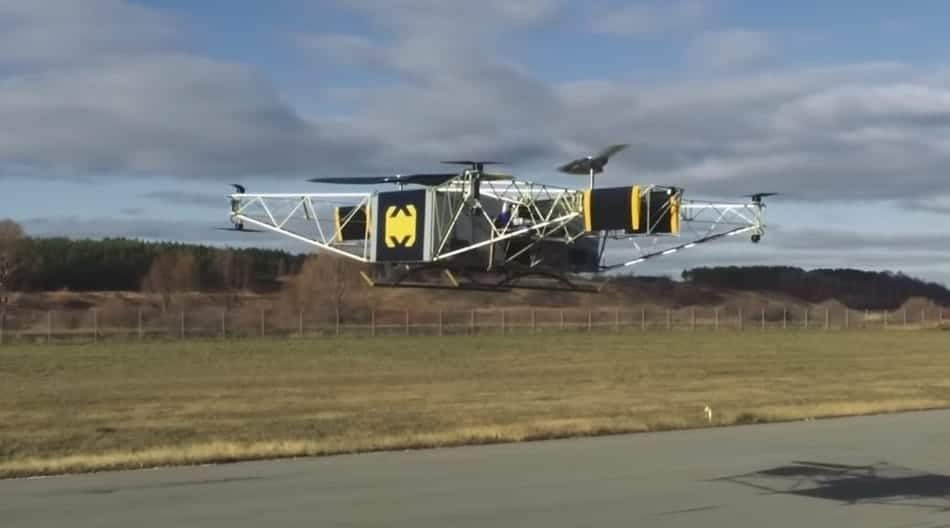
The maximum weight that a drone can carry is expressed as “payload”. UAVs have proven to be really useful and adaptable, but payload capacities are often a significant limiting factor. This is especially true for micro aerial vehicles that are showing promise in search and rescue missions. On the other hand we have proffesional drones that are design to carry extra weight. There are drones that are powerful enough to carry 2 people, so you can imagine the potential for drones today.
So What Drone Can Carry The Most Weight? This Russian “hulk” SKYF drone holds the Guinness World Record for the heaviest weight to be lifted by a remote-controlled multicopter. SKYF drone can carry of up to 250 kg (550lbs), with a perspective of increase up to 400 kg (880 lbs) with flight range up to 350 km (220 miles) and its flight duration up to 8 hours.
The SKYF team has built a universal drone that has the highest recorded load capacity of all drones. SKYF has created a unique aerodynamic system that differs from other drones, thus giving it the highest possible payload capacity.. The engineers calculated that a flight hour of a SKYF is more then a ten times lower then a flight hour of a helicopter. SKYF drone uses ordinary gasoline (petrol) instead of expensive aviation fuel that makes maintenance cheaper and more accessible.
SKYF Drone – Best Heavy Lift Drone On The Market
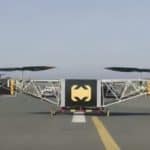
SKYF is a heavy lifting autonomous drone with vertical take-off and landing capabilities. None of the commercially avaliable solutions that are today on the market fully satisfy the demands. It dramatically exceeds today’s multirotor drones in flight time and carrying capacity. Maximum useful load for SKYF is 400 kg (880 lbs), flight range is 350 km (220 miles) and the flight time is up to 8 hours. Skiff engineer’s made this possible by separating the gasoline-powered lift of the 2 large blades from the directional and balanced control of the 8 smaller electric raids. This unique flight design was concevied by SKYF’s founding engineers in 2016 and developed into a company with a vision and business model. SKYF’s drones have performed multiple flight tests in various conditions including harsh winter weather with wind gusts up to 20km/h and temperatures -20’C.
| Skyf Drone | |
|---|---|
| Flight Range: | Up to 350km |
| Flight Duration: | Up to 8h (with 50kg payload) |
| Maximum speed: | 70km/h |
| Flight height: | 5 to 3000m |
| Positional accuracy: | Within 30 cm precision |
| Fuel: | Petrol |
| Max Payload: | 400 kg |
Griff 300 – #2 Best Heavy Lift Drone On The Market
The drone company Griff Aviation has launched the Griff 300 model UAV that can carry around 500 lbs (226kg) of payload weight. Griff 300 is an 8-propeller UAV with a very high power. Another interesting thing about this drone is that can sustain 45 minutes of airtime. When we consider the weight that some drones need to carry, a typical professional camera weighs about 2 kg, and these are the minimum requirements that professional drones must satisfy.
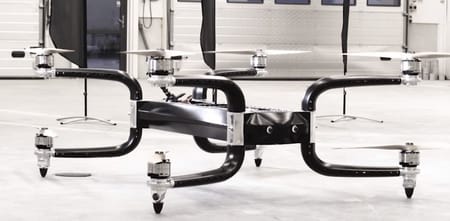
Griff Aviation’s UAVs will be priced from
around $250,000 but this price is not final, it depend upon the
customer’s requirements. One of the important features of the GRIFF 300 drone is easy to transport, assemble and operate. Also, one great feature is also great emphasis on the ease of interaction between the person piloting the drone and its control systems. For example, if the customer wishes, he can use a helicopter cockpit or a captain’s chair, with full view of the map, telemetry and video feed. If you are interested in more, I wrote an article about The Griff 300 Review.
| Griff 300 | |
|---|---|
| Dimensions: | 265cm x 280cm x 50cm |
| Dimensions folded: | 90cm wide x 160cm |
| Rated payload: | 150Kg (45 min) |
| Max payload: | 226 kg (500lbs) |
| MTOW : | 350kg |
Professional Drones For Carrying Weight
When we talk about professional drones (UAVs) that are used for industrial or military environments, they are primarily designed to carry extra weight while flying. That extra weight, whether it is a camera to film, inspect or monitor it can also carry things like sensors, LiDar system, Drone mapping technology or other elements useful for industrial jobs. These drones can carry impressive loads, because it is their original purpose and these batteries are designed to handle that extra weight and so they don’t lose flyight time. For example some drones can carry payload of 6kg, while their weight is only 10kg, which is more than 50% of its weight. This market is still developing so we are witnessing a real battle of who will take over the market of payloads trasnported by drone. If you want to know more, I wrote an article about 15 Best Heavy Lift Drones In The World.
What’s The Future For Drones Carrying Payloads?
It’s just a matter of time when Drones have the potential to eliminate the challenges people face every day. Drone delivery is inevitable, it’s just a matter of time. When regulation loosen up and the infrastructure is in place, we will be seeing drone deliveries for many purposes. Drones could enable a step change in the availabiliy of everyday physical items. One of the main advantages of drone deliveries is speed. When you want something fast, you almost certainly want it delivered right to you.
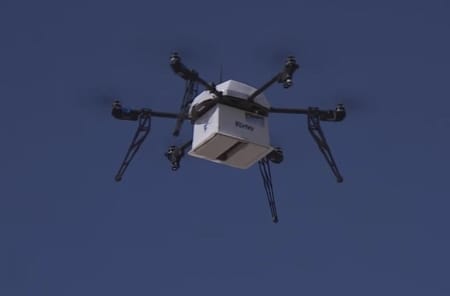
The future is to summon an item with a button on your smartphone and shortly afterwards, pluck it out of the air directly in front of you, and the future potential goes beyond adding convenience to online shopping. Pinpoint accurate delivery to any smartphone may improve the feasibility of life-saving applications for drones such as EpiPen or defibrillator deliveries. For about 10 years when drone technology will allow us to carry heavier loads for longer distances will change everything.
Taking Off and Hover Condition of Drone
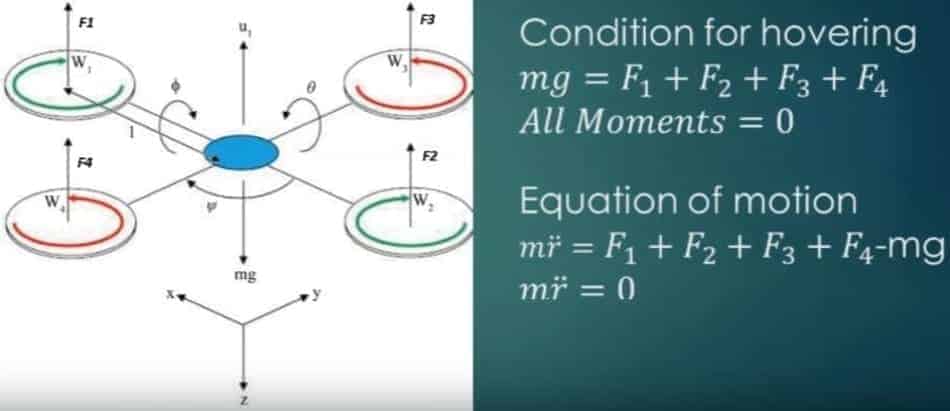
So how the quadcopter hovers in air? To Rise above the ground, the drone need a net upward Force. As a quadcopter is steady in air, it must be in equilibrium. The Motors of the drone generate thrust that is greater than the weight of quadcopter, making the quad rise upwards. All the forces must be balanced, and the total thrust F1 + F2 + F3 + F4 produced by the propeller must be equal to the weight of the quadcopter and all the moment produced must be equal to 0. The governing equation of the motion in this condition is “All moments =0”. Motors generate thrust. In case of rise motion the net thrust produced by all the propellers it more than the weight of the quadcopter. This result in output motion of quadcopter, which in such case is mr>0. For drop motion the thrust produced by all the propellers must be less than the weight of the quadcopter.
How Fast Can a Heavy lift Drone Go?
Short answer is “it depends”. Most of the drones you’d find on the internet (Amazon) at the price under $1000 have the speed under 60 mph. This is one of my favorite racing drones: HGLRC Wind5 6S. On other hand, commercial drones have higher speeds, and in this category are also racing drones. Some of the professional drones (quads) can break the 100 mph speed mark. One of the factors that you need to consider is air density, what a lot of them completely ignore when they fly a drone. Same goes when you fly your drone in differing temperatures and altitudes. Every drone has a rated service ceiling which means rating based entirely on the drone’s ability to handle air density.

